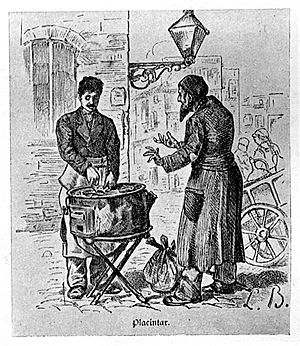Placenta cake facts for kids

A Greek plăcintă-maker in Bucharest in 1880.
|
|
| Type | Pie |
|---|---|
| Place of origin | Ancient Greece, Ancient Rome |
| Main ingredients | Flour and semolina dough, cheese, honey, bay leaves |
| Variations | plăcintă, palatschinke |
Placenta cake was a popular dessert in Ancient Greece and Rome. It was made with many layers of dough, mixed with cheese and honey. People also added bay leaves for flavor. After baking, it was covered in more honey.
This sweet treat is mentioned in old writings. You can find it in Greek poems by Archestratos and Antiphanes. It also appears in De agri cultura, a book by Cato the Elder.
What Does "Placenta" Mean?
The word placenta comes from the Latin language. It got its name from the Greek word plakous. This Greek word means "flat" and was used for thin, layered flat breads.
Interestingly, the biological placenta (the organ that connects a baby to its mother before birth) was named after this cake. People thought the organ looked similar in shape to the flat, round cake.
A Look Back in Time: History of Placenta Cake
One of the first times plakous is mentioned as a dessert is in the poems of Archestratos. He wrote that plakous was served with nuts and dried fruits. He especially liked the version from Athens that was soaked in honey.
Antiphanes, another Greek writer from the 4th century BC, gave a detailed description. He said plakous was made with wheat flour and goat's cheese. He described it as a delightful mix of "the streams of the tawny bee" (honey) and "the curdled river of bleating she-goats" (cheese).
Later, around 160 BC, Cato the Elder shared a recipe for placenta in his book De agri cultura. Many experts believe Cato's dessert recipes were inspired by Greek cookbooks.
Here is how Cato described making it:
- First, you would place a row of thin dough sheets called tracta on the bottom.
- Then, you would spread a mix of cheese and honey over it.
- You would keep adding layers of tracta and the cheese-honey mix until it was all used up.
- The top layer would be tracta.
- Finally, the placenta was baked in an oven with a heated lid on top.
- Once it was ready, more honey was poured over it.
Some experts think that the plakous and placenta desserts led to later dishes. For example, plakountas tetyromenous (cheesy placenta) and koptoplakous from the Byzantine Empire might be the ancestors of modern tiropita (a Greek cheese pie) or banitsa (a Bulgarian pastry).
Today, on the Greek island of Lesbos, a dessert called placenta (πλατσέντα) is still made. It is similar to baklava, with layers of pastry filled with crushed nuts. It is baked and then covered in honey.
The dessert also traveled to other places. Through its Byzantine Greek name plakountos, it became plagindi in Armenian cuisine. This led to the Arabic name iflaghun, which was a special dish of the Cilician Armenians. This shows how the dish might have spread to the Middle East long ago.
Placenta Cake's Legacy Today
The word placenta and its related forms are still used for food names in the Balkans region.
- In Romania, you can find plăcintă. This is a baked flat pastry, often filled with cheese.
- In Serbia, there are Palačinke. These are very thin, crepe-like pancakes. They are usually rolled with sugar and jam, or served with nuts and dried fruits.
- On the Greek island of Lesbos, as mentioned, πλατσέντα is a baked dessert. It has very thin pastry layers and chopped nuts. The dough for this modern placenta is soaked in a sweet syrup, and sometimes Ouzo is added to the dough.
la:Placenta (libum)#Ferculum Romanorum

